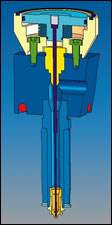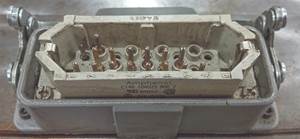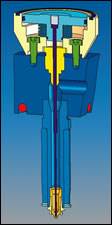Weldless Technology Eliminates Weld Lines on Molds
A new patent-pending process that eliminates weld/knit/parting lines of molds has been developed by a consortium of alliance partners.
A new patent-pending process that eliminates weld/knit/parting lines of molds has been developed by a consortium of alliance partners of which Makino (Auburn Hills, MI) has developed the machining applications of the process.
According to Sean Shafer, Makino’s Business Manager of Makino Die/Mold Technologies, market demands for higher part quality have led to the development of this technology. “The key to this procedure is the use of advanced technology vertical machining centers to manufacture the mold in new ways, and highly efficient heating and cooling cycle techniques used during the injection molding process,” he states.
This coordination of technologies helps to eliminate weld lines, and thus enhance part accuracy, finish and appearance while decreasing mold cycle times by highly efficient control of the molding process, Shafer notes. The process can be used with most plastic resins and glass-filled material, and was developed for high-end applications such as automotive dashboard or consumer product covers. It eliminates secondary coating processes by providing outstanding surface finish as well preventing dimensional change caused by secondary shrinkage.
Weldless Mold Development
Craig McQueen, milling team leader for Makino’s Die/Mold Technology Center and applications engineer Mark Patterson coordinated the project for Makino. According to McQueen, the elimination of weld lines requires modern machine tools combined with a few new techniques. “With this new weldless process, the near-net shaped cores and cavities are milled with a fourth axis to eliminate movement and re-clamping to improve dimensional tolerances,” he explains. “Plate ridges and ribs along with a more extensive use of water chamber cooling lines provide for a higher quality, weldless finish.
“In older processes, cooling lines ran near the mold surface, and the output finish was not always balanced and even,” McQueen continues. “In some newer processes, water flows through the core and cavity cooling lines, near the injected resin areas, which provides a better output.”
Effect on the Mold Build Process
According to McQueen, changes in the channel design of the molds helps eliminate optimal temperature variation in the heating and cooling of the mold during the actual molding process. “Maintaining temperature fluctuation to within 60 degrees is accomplished through the milling of medium diameter penetration chambers strategically located in the mold,” he states “These penetration chambers—milled on the back side of a mold cavity—conform to the cavity shape and serve as a conduit for compressed steam and cooling water to make heat conductivity of the cavity surface more uniform. These chambers maintain the temperature variance and the speed at which the temperature fluctuates.”
The cost of mold production is reduced due to the elimination of setup time and accompanying cycle time improvements when milled with an airborne, multi-surface vertical machining center to enhance reliability. The machining center must also be equipped with a specially designed clamp and vise system (Rotary Smart Vise), which allows the workpiece to be turned for four-sided machining of a core or cavity in one setup. “The surfaces are alternately and continuously machined and indexed with high efficiency and effectivenes, reducing cycle and leadtimes,” McQueen notes. “This process is not possible with a standard horizontal machining center."
The Makino system first indexes a workpiece at a certain necessary angle and then machines the surface, McQueen points out. “Special CAM software is not necessary,” he comments, “as indexing the workpiece at an angle and moving the coordinate value according to that index can be controlled and corrected by the CNC equipment.
“The process produces no warping or deformation, and there are no challenges to matching the cavity with the core-side mold piece,” McQueen adds. “Also, due to the capability to tilt the workpiece, you can avoid machining with the tip of a ball mill end—increasing tooling life.”
Additional advantages include the virtual elimination of the need for coating and annealing, improved surface finish, the prevention of shrinkage on finished parts, and reduced cycle time. The weldless process is ideally suited for exterior components for household apparatus, mobile phone and lap top computer cases, and video and digital camera devices. It also is suitable for large-scale display unit bezels and the exterior automobile components.
Related Content
How to Maintain Heaters, Thermocouples, Valve Gates and Controls
An examination of real-world problems and solutions involving hot runner system maintenance.
Read MoreQuestions and Considerations Before Sending Your Mold Out for Service
Communication is essential for proper polishing, hot runner manifold cleaning, mold repair, laser engraving and laser welding services.
Read MoreVIDEO: Hot Runner Maintenance Tips
Scott Clark, Hot Runner Business Manager for Husky Technologies, breaks down maintenance practices for hot runner systems.
Read MoreLaser Welding Versus Micro Welding
The latest battle in finely detailed restoration/repair of mold materials.
Read MoreRead Next
Evaluating Gate System Designs
A hybrid gating option combines the advantages of valve gate and thermal gate systems.
Read MoreAre You a Moldmaker Considering 3D Printing? Consider the 3D Printing Workshop at NPE2024
Presentations will cover 3D printing for mold tooling, material innovation, product development, bridge production and full-scale, high-volume additive manufacturing.
Read MoreHow to Use Strategic Planning Tools, Data to Manage the Human Side of Business
Q&A with Marion Wells, MMT EAB member and founder of Human Asset Management.
Read More





.jpg;maxWidth=300;quality=90)


_300x250 4.png;maxWidth=300;quality=90)




.png;maxWidth=300;quality=90)








